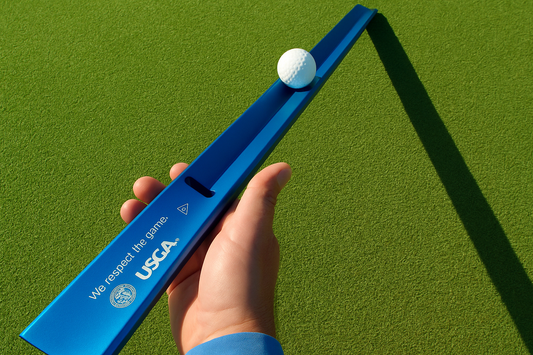Green speed is perhaps the most misunderstood yet critically important aspect of golf course management. After studying countless putting surfaces and watching thousands of golfers struggle with lightning-fast greens, I know firsthand how understanding green speed can transform someone's putting.
If you've ever muttered under your breath after watching your seemingly perfect putt race 10 feet past the hole, or felt the frustration of leaving every putt short on slow greens, this comprehensive guide is for you. I'll walk you through everything you need to know about the Stimpmeter and green speed.
What is the Stimpmeter in Golf?
The Stimpmeter is deceptively simple. It is an aluminum bar with a V-shaped groove running its length. This unassuming device revolutionized how we understand, measure, and maintain putting greens.
Invented in 1935 by Edward S. Stimpson, Sr., a Massachusetts state amateur champion and former Harvard golf team captain, the Stimpmeter was born from frustration. While watching the 1935 U.S. Open at Oakmont, Stimpson witnessed a putt by Gene Sarazen roll off a green. Convinced the greens were unreasonably fast, Stimpson wondered how he could objectively prove it.
His solution was ingenious in its simplicity—a wooden device that would release a golf ball at a consistent velocity, allowing the distance it rolled on a green to be measured. This distance, measured in feet, became known as the "speed" of the green.
Stimpson's original wooden prototype remained largely unknown until the mid-1970s, when the USGA's Frank Thomas redesigned it using aluminum. The USGA first used this updated version during the 1976 U.S. Open at Atlanta and made it available to golf course superintendents in 1978.
In 2013, the USGA introduced a third-generation Stimpmeter, painted blue rather than green, manufactured to higher engineering tolerances for improved accuracy and precision. This newer model also features a second notch on the reverse side, allowing for measurements on more undulating greens where the standard measurement might not be possible.
How to Find a Green's Speed
Finding a green's speed isn't just about dropping a ball and seeing how far it rolls. There's a precise methodology that ensures consistent, reliable measurements.
The standard Stimpmeter is an extruded aluminum bar, 36 inches long, with a V-shaped groove extending its entire length. The groove supports the ball at two points, 0.5 inches apart, creating a slight but consistent overspin when the ball rolls.
The process begins by selecting a level area on the green, approximately several feet wide and 10 to 12 feet long. The tapered end of the Stimpmeter rests on the ground, while a golf ball is placed in the notch at the raised end. As the Stimpmeter is slowly elevated to about 20 degrees, gravity pulls the ball from the notch, sending it rolling down the groove and onto the green's surface.
This procedure is repeated with three balls, all of which should come to rest within 8 inches of each other. If they're spread wider, it suggests inconsistency in the measurement process or the putting surface itself. The average stopping point of these three balls marks the end of the first measurement.
The true genius of the Stimpmeter methodology is that it accounts for subtle variations in the green by measuring in both directions. The entire process is repeated in the opposite direction along the same line. The average of these two measurements—the distance in feet that the ball rolls—gives us the green speed.
For particularly undulating greens where finding a 12-foot level area is impossible, the newer Stimpmeters include an alternate "2X" notch on the reverse side. This allows testing on level areas as short as 6 feet, with the measured distance multiplied by two to calculate the green speed.
The Influence of a Green's Speed

Green speed influences every aspect of putting, from how hard you strike the ball to the amount of break you need to play. It's the invisible factor that can make identical-looking putts behave completely differently from one course to another.
When we talk about green speeds, we're generally working within a range from about 7 feet (very slow by modern standards) to 14+ feet (extremely fast, typically reserved for major championships). Most recreational golfers regularly encounter greens that measure between 8 and 10 feet on the Stimpmeter.
The USGA has established general guidelines for green speeds:
For regular play:
-
Slow: 8 feet
-
Medium: 10 feet
-
Fast: 12 feet
For championship play:
-
Slow: 10 feet
-
Medium: 12 feet
-
Fast: 14 feet
The greens at Oakmont Country Club, where Stimpson first conceived the Stimpmeter, are renowned for their speed, often measuring 15 feet or more. Golfers are putting on what essentially feels like polished marble.
But faster isn't always better. Green speed must be balanced against other factors, including:
Green Contours: Severely sloped or undulating greens become virtually unplayable when too fast. Even the slightest touch sends the ball racing past the hole.
Weather Conditions: Wind can turn fast greens into a nightmare, with balls moving even when seemingly at rest. This is why the Old Course at St. Andrews, despite hosting The Open Championship, typically maintains green speeds around 10.5 feet to account for the notorious Scottish winds.
Pace of Play: Extremely fast greens slow down play dramatically as golfers face more three-putts and spend more time carefully analyzing the subtle breaks.
Golfer Skill Level: While professionals might thrive on lightning-fast greens, the average golfer often finds them frustrating and unenjoyable.
Turf Health: Maintaining extremely fast greens puts tremendous stress on the grass, potentially leading to disease and other maintenance issues.
For golf course superintendents, finding the right green speed is a delicate balancing act. They want it to be fast enough to provide a true roll and test golfers' skills, but not so fast that the course becomes unplayable or the turf suffers.
How Advances in Turf Have Changed Green Speeds
The evolution of green speeds over the past century tells a fascinating story of changing expectations, technological advancements, and agronomic innovations.
When Eddie Stimpson first measured green speeds in the 1930s, the average reading was a mere 2.5 feet—a pace that modern golfers would find painfully slow. Remarkably, when Stimpson took measurements again between 1946 and 1973, the average remained unchanged at 2.5 feet, including the greens at the 1963 U.S. Open, which measured just 2.7 feet.
This consistency makes sense when we consider the history of putting green maintenance. In 1922, the first reported mowing height was approximately 0.375 inches. By 1930, research suggested putting greens should be mowed at 0.187 inches daily. A 1947 survey found that 29% of courses mowed at 0.187 inches, 40% at 0.25 inches, and 31% at 0.312 inches. As late as 1973, James Beard wrote that mowing heights were as low as 0.2 inches.
The dramatic shift came in the mid-1970s, coinciding with the USGA's modification of the Stimpmeter. When the USGA measured over 1,500 greens across 36 states in 1976 and 1977, they found an average green speed of 6.5 feet—significantly faster than Stimpson's earlier measurements but still slow by today's standards.
Several factors contributed to this acceleration in green speeds

Mower Technology: The development of thinner bedknives and more precise mowers allowed superintendents to cut grass as low as 0.125 inches without damaging the turf.
Improved Grass Varieties: Bentgrass and Bermuda grass varieties have been specifically bred for putting greens, creating denser, more upright growth patterns that provide smoother putting surfaces even at extremely low cutting heights.
Advanced Maintenance Practices: Techniques like rolling, verticutting, and precise topdressing have allowed superintendents to create faster, more consistent green speeds without lowering mowing heights to dangerous levels.
Irrigation and Drainage Systems: Modern systems allow for precise control of soil moisture, helping maintain firmer, faster surfaces.
By 1978, when the USGA officially released their Stimpmeter, only 2% of golf courses had green speeds over 9.0 feet. Today, speeds of 10-12 feet are common at well-maintained courses, with championship venues often exceeding 13 feet.
This evolution reflects changing golfer expectations, largely driven by television coverage of professional tournaments. When viewers watch putts rolling smoothly on pristine, lightning-fast greens at Augusta National during The Masters, they naturally want similar conditions at their home courses.
However, this pursuit of speed comes with costs—both financial and agronomic. Maintaining very fast greens requires more labor, more specialized equipment, and puts greater stress on the turf. Many courses have found that slightly reducing green speeds can significantly improve turf health while still providing an excellent putting surface.
The most forward-thinking superintendents have discovered that green speed isn't just about mowing height. Strategic rolling can actually produce faster, healthier greens than extremely low mowing. Research has shown that rolling in place of occasional mowing can lead to faster green speeds while promoting healthier turf at lower maintenance costs.
Finding the Sweet Spot for Your Game
Understanding green speed isn't just academic. It has practical implications for every golfer. Knowing the Stimpmeter reading of a course you're about to play can help you prepare mentally and adjust your putting stroke accordingly.
On faster greens, a lighter touch is essential, with focus on a smooth, pendulum-like stroke that minimizes hand action. For slower greens, a more aggressive stroke is needed to get the ball to the hole, often requiring more hand action and a firmer hit.
The next time you're struggling with distance control on the greens, consider asking the pro shop or superintendent about the day's Stimpmeter reading. This single piece of information can transform your approach to putting and potentially save you several strokes per round.
For golf course operators and superintendents, the Stimpmeter provides an objective way to measure and maintain consistency across all putting surfaces. By taking regular measurements and keeping detailed records, maintenance practices can be fine-tuned to achieve the desired speed and consistency.





